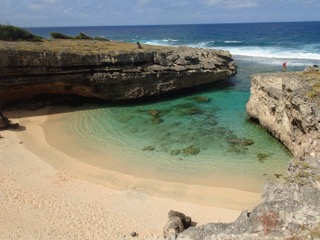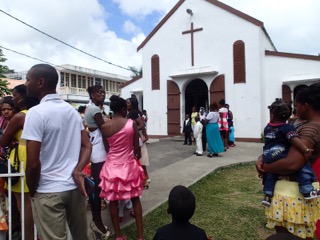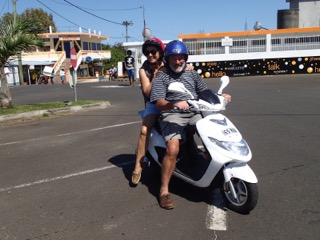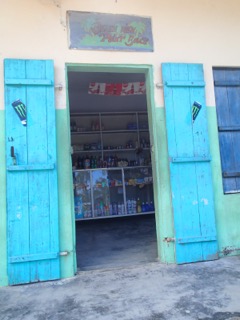Rodrigues 2

VulcanSpirit
Richard & Alison Brunstrom
Mon 28 Sep 2015 15:45
| Computer problems have continued to bedevil my attempts to post Blog updates, but I think I have it licked for now, thanks to the assistance of fellow cruiser Mike Reynolds with whom we have been travelling from Fremantle. So, back to where I left off, in Rodrigues: The Mascarene Isles (Reunion, Mauritius and Rodrigues) are world infamous for the destruction of their wildlife, especially of course the extraordinary Mauritian dodo. The islands had the misfortune to be located right in the path of the early European explorers venturing around the southern tip of Africa and making their way to the fabulous wealth of the East Indies in the days before science, before any understanding of the concept of sustainable yield. Natural resources were thought to be placed on the planet by God, to be exploited by man (a Bronze Age concept sadly and incredibly being echoed by conservative voices in modern America this very week). The islands were discovered by Arab adventurers in the tenth century, named by the Portuguese and the Dutch in the sixteenth and, in the case of Rodrigues, first settled by the French in the seventeenth. The very first human inhabitant of Rodrigues was Francois Leguat, a French Huguenot exile who was dumped here by deception in 1691; the island at that time was in its pristine state and very fortunately Leguat was interested in his environment. He took copious notes of the plants and animals he found during his three year stay on the island; these notes were later published in London as one of the world’s very first natural history books, recording in detail an island environment which had almost entirely vanished only one hundred years later. There were two species of giant tortoise, several very large geckos as large as a man’s forearm, at least twenty species of endemic bird including the large flightless and enigmatic solitaire and large herds of dugong in the huge fringing lagoon. Serious French settlement took place from 1726, and by the end of the century almost all the native wildlife had gone, swept away in an orgy of exploitation. Just three vertebrates have survived - two small birds and a fruit bat, all rescued from very near extinction in the last few years. Unknown numbers of endemic plants have gone, but some remain, often critically endangered. The forests were totally cleared, burnt off by tortoise hunters and felled for valuable hardwoods. A veritable catastrophe and an object lesson for the rest of the world. Rodrigues, an island the size of Jersey, is today an autonomous part of the nation state of Mauritius. It has a population of 38 000 (cf 1.2m on Mauritius) who get by on farming and fishing. It is in the Tropics, just, and in the cyclone belt so not a good place to be in a yacht at the wrong time of year (this, you will glad to read, is the right time of year). Here are a couple of typical views:   The picture on the left is of Anse Bouteille (Bottle Beach) on the east coast. I’m on the cliff top which rather surprisingly on a relatively young volcanic island is of limestone. You can see the fringing reef, here immediately offshore, with the deep blue Indian Ocean just beyond. The limestone is formed from windblown coral sand which eroded off the exposed coral reefs when the sea level was much lower during the ice ages and has subsequently been cemented in place by acidic rain. The second picture is a typical inland view with well-tended fields of vegetables and other crops on fertile volcanic soil in the valley with a barren sparsely vegetated ridge (there are lots of goats) in the background. About 97% of all vegetation on the island is now ‘exotic’ (i.e. of off-island origin); the scale of environmental destruction here in the early years is really difficult to comprehend. The population is 95% Creole (their description, meaning of mixed European/African descent); the official language is English (Mauritius was a British colony from 1809 to 1968) but the locals speak Creole (70% French, 15% English and the rest a variety of African words) or French with very little English understood. Traffic drives on the left, all official signs of every sort are in English, the electric plugs are British style and the police are unarmed. Barclay’s Bank is in the main street. And importantly, the people are extremely friendly. There is none of the antagonistic atmosphere that so badly afflicts much of the Caribbean. Tourists are few and far between - Rodrigues saw only 57 yachts in the whole of last year, and the airport is too small for jets - and we have been warmly greeted everywhere. People here, though far from rich, take great care with their appearance. Schoolchildren are all immaculately turned out in brightly coloured uniforms (and impeccably behaved - they could teach their contemporaries in the UK a thing or two). This is the crowd turning out from the Catholic church in their Sunday best; note how healthily thin everyone is by comparison with us in the developed world:  The best way to see the island is on a scooter; here is the Martin part of the crew doing their best hairy biker impression:  And you just have to love those island colours:   Sadly satellite time prevents a longer Blog (no wifi here!), so I’ll stop for now. Other Blogposts following on, inter alia, creole cooking and, somewhat inevitably you might think, flora and fauna. |